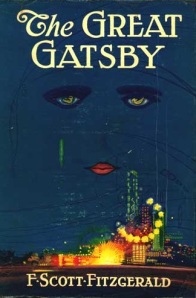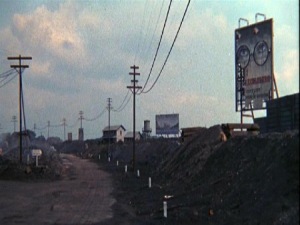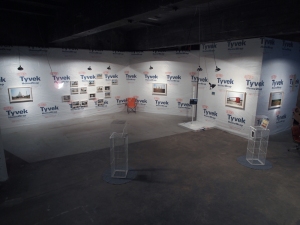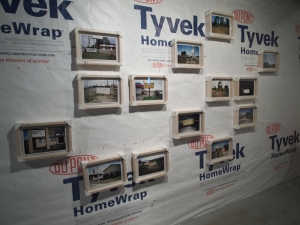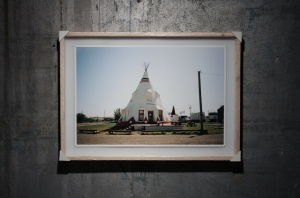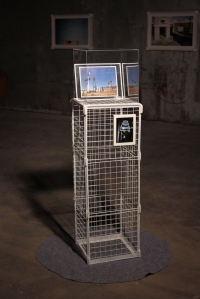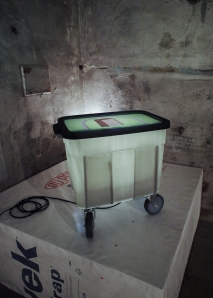Tagged: f scott fitzgerald
Signs, Signs! Everywhere There’s Signs!
by Reggie Michael Rodrigue
A cover of “The Great Gatsby” by F. Scott Fitzgerald
In the novel “The Great Gatsby,” the penultimate meditation on the dark heart of America in the Roaring 20’s, the author F. Scott Fitzgerald introduces his readers to a profoundly denatured landscape – a modern wasteland – known as the Valley of Ashes. It is a toxic zone where industrial ash is dumped between the embarrassingly affluent, new money enclave of West Egg, Long Island and the bright lights and big dreams of New York City. In the context of the novel, the Valley of Ashes symbolizes the spiritual, social and environmental decay that is the end result of a life spent in the unbridled pursuit of wealth, consumption and pleasure at any cost.
An ashpile
Within Fitzgerald’s wasteland, particular interest is paid to signage and advertisements. As the American economic engine of the 1920’s raced into its seemingly dazzling future with the fury of a hellbent Duesenberg after WWI, advertising was there to stoke it’s fire. Consumerist culture reached a new apex in the 1920’s due in large part to the nascent proliferation of newspapers, magazines, leaflets, billboards, electric/neon signage and radio. All of these media converged on the nation and advertised the latest and greatest innovations to a public desperate to move past the horrors of the war into a modern, gleaming pleasure dome of unknown convenience and luxury.
The cultural landscape of the nation succumbed to desire, and Fitzgerald was keenly aware of this. The most potent and terrifying symbol in “The Great Gatsby” is not the Valley of Ashes itself, but a faded billboard located in this liminal zone. The billboard advertises the practice of occulist, Dr. T.J. Eckleburg. The billboard simply presents the large, bespectacled eyes of the doctor hovering over all of the desolation. On one hand, the billboard represents the eyes of God judging America from on high. On the other hand, the billboard obliquely represents an erosion of progressive vision and meaning in a land engulfed in wantonness and consumption. Fitzgerald seemed to be saying that when all of the images a people hold sacred are foisted back on them for the purposes of selling toothpaste, gasoline and soda, the world becomes meaningless and a vacant shell only suitable to be filled with more commodities and the refuse left behind after the act of consumption has taken place.
Recreation of the Valley of Ashes with Dr. T. J. Eckleburg’s Billboard as described in F. Scott Fitzgerald’s “The Great Gatsby”
Nearly a century after Fitzgerald’s time, the transformation of America by capitalists and the media into the world’s used car lot is complete. Nearly every square inch of America has become mediated for the purposes of selling something, whether it’s cars, smart phones, breakfast cereal, insurance and healthcare, public schools, ideas and even you, dear reader. You’re being sold, too. Take some time to look up what a “data broker” is and delight in the fact that personal information about your life and what you buy is a commodity as well – to be schilled to corporations thanks to the ease of aggregating terabytes of data by way of the ubiquity of digital technology in our lives. The implications of this brave, new world of consumer data mining are vast. Whereas the media of the 20th century was all about creating large, singular marketing projects that were meant to carpet bomb the cultural landscape of the time for mass effectiveness, the media of the 21st has learned to be a lot more insidious and personal. After all, what company really needs billboards anymore, when said company can interact and send perfectly targeted advertisements to prospective consumers through Facebook and other social media sites selling your personal information, where the masses commune alone-together inside the pseudo-privacy of their digital bubbles.
In this sense, pop culture has begun to eat us and itself. We’ve begun to be nostalgic for a simpler time when pop was a high-wattage diner sign gleaming on the horizon, the kooky messages and curt phrases of letterboards or a homemade advertisement slapped together by a mom-and-pop store. To us in the 21st century, these things now seem quite Romantic-with-a-capital-R. The fact is that many of these artifacts of early consumerist culture are either in a state of half-life, ruin, or they are vanishing from the cultural landscape altogether. Inspect any new Apple Computer Store and take a whiff of what’s to come. This is the future- and this as well. Seamless consumption! Today, the Romance-quotient of earlier forms of advertising and marketing blooms like a cross between a Googie architecture sunburst and a Caspar David Friedrich painting of a gutted church in the wilderness. We remember the good old days of coming together in person under the auspices of that banal yellow Waffle House sign to worship Baal covertly in plain sight while stuffing our faces with hashbrowns, pork sausage patties and eggs, and it was good (even though Waffle Houses still dot the American landscape). How metamodern of us – to be nostalgic for something that is still with us, although in a degraded form! Amen!
The reason for all of my babble about advertising, consumerism and nostalgia is an art exhibition at May Gallery by two artists from Brooklyn, New York – Alli Miller and Trey Burns – in the St. Claude Arts District of New Orleans . The exhibition is titled “Wessel Castle,” a portmanteau derived from combining the beginning of pop artist Tom Wesselmann‘s surname with the “Castle” in White Castle, the burger chain known for deliciously shitty, little square burgers with steam holes in them that have attracted rabid fans across our nation – most notably the writers of “Harold and Kumar Go to White Castle.”
Title wall for Alli Miller and Trey Burns “Wessel Castle” exhibition at May Gallery
Installation view of “Wessel Castle” with title wall at May Gallery
Installation view of “Wessel Castle” at May Gallery
Installation view of “Wessel Castle” at May Gallery
Installation View of “Wessel Castle” at May Gallery.
Images of Wesselmann’s works or White Castle chains are non-existent in the exhibition, but by invoking them, Miller and Burns set up a dialectic for the show that casts a pall over the exhibition while still evoking the Romantic. In the 1950’s and 1960’s, when Wesselmann and White Castle had hit their stride as cultural zeitgeists, they stood for a confluence of cultural ease, efficiency and sensual delight that was America’s promise at the time. Within “Wessel Castle”, we, the audience, are left with the abject physical and metaphysical fallout from such short-sighted lines of thought along with a heaping dose of nostalgia for a simpler, less complicated time.
The exhibition is mostly a photographic exploration of the cultural backwaters and architectural relics that fit into the rubric of what Wesselman and White Castle represent to us today. However, Miller and Burns’ images are all presented to us on a ground of Tyvek – the relatively new industrial insulating material which the long-standing, corporate giant Dupont advertises as “Superior protection against water and air infiltration. Improved energy efficiency & air quality.”
Tyvek is actually quite a humorous and ironic choice in which to cover the walls of the exhibition. Here, Miller and Burns exploit the material due to it’s connection to New Orleans, a city still in the process of rebuilding itself after the devastation of Hurricane Katrina. Visit any ward in the middle of a revitalization in New Orleans, and one will surely see Tyvek being placed on new homes and buildings. Tyvek was also the material of choice for the protective suits worn by first responders and clean-up crews after the hurricane. Beyond this connection, one can also view the Tyvek of the exhibition as a sly recreation of red carpet backdrops at major entertainment events that advertise which companies have supported the event proceedings with funding. The Tyvek background of “Wessel Castle” forces the viewer to question the sincerity of the nostalgic/Romantic photographs on view.
There is another questionable presentational device in the exhibition as well. Each wall-mounted photograph in the exhibition is presented in a frame with its protective, cardboard, cornice sleeves in tact. A quirky, little touch like this has a big impact, demanding one question the intent of the artists. Are the sleeves there to offer protection to the fragile images, or are they there to mock them as freshly minted commodities? Personally, I think that they do both.
Within the images of “Wessel Castle,” Miller and Burns point us toward a couple of strange roadside attractions and a preponderance of billboards and letterboards in various states of disarray.
In “Espresso,” the viewer is asked to contemplate the kitschy glory of a coffee shop housed inside a concrete replica of an American Indian tepee.
Alli Miller and Trey Burns, “Espresso,” photograph
“We Buy Gold” is a beautifully haunting image of a repurposed Waffle House sign hovering over a motel pool surrounded by trees. The combination of the reflective, blue water, shady trees and the deadpan audacity of the towering yellow sign advertising a pawn shop/gold exchange lure one into the image. The photograph is drowsy with cheap luxury and the sort of blue sky noir one finds in David Lynch films.
Alli Miller and Trey Burns, “We Buy Gold,” photograph
On one of their roadtrips, Miller and Burns were lucky enough to come across a Geico Insurance advertisement via skywriting. The photograph “Geico Geico” is the end result of this coincidence. Here, the name of the company hiccups across the sky in short puffs of smoke while a street light seems to reach up and underscore the advertisement.
In “Untitled (Road Signs),” a quartet of cacti are adorned with wooden ladders or supports for some mysterious reason. They rise in isolation from a desert landscape while vehicles and highway signs dot the horizon behind them.
In another photograph of a nearly barren landscape, “Museum Next Exit,” a shoddy, utilitarian sign advertises the near presence of culture behind a barbed wire fence.
Alli Miller and Trey Burns, “Museum Next Exit,” photograph
“Untitled (Memorial)” commemorates a hilltop site of remembrance capped by a white cross and a propped-up wooden rainbow. The image is equally beautiful and pathetic.
“Untitled (Geometric Sign)” presents the top of a disused and repurposed highway sign peeking out into a serene sky from the bottom of the photograph. What purpose this sign has now seems to be a mystery since all that occupies it in the image are modernistic blocks of color. Maybe the sign points the way to some type of secret Bauhaus utopia off one of America’s lost highways?
The last of the quasi-yet-hyper-surreal images in “Wessel Castle” is “Untitled (Double Horizon),” which provides the visual enigma of a painted desert landscape on a shipping container located in the middle of an actual desert landscape. It’s one of the smarter and more enchanting images in the exhibition. The artifice of the painting (despite its clumsy nature) seems more real by virtue of the stupendous bluntness and incongruence of the shipping container supporting it. It’s as if one can step into the landscape a second time through the painting on the container. “Untitled (Double Horizon)” one-ups the work of Rene’ Magritte and is a sly homage to the surrealist/advertising man who could also be a spiritual father of the work in the exhibition.
Alli Miller and Trey Burns, “Untitled (Double Horizon),” photograph
Along with the images above, one must wrestle with the achingly banal yet disconcerting images of abused, neglected or abandoned letterboard signs communicating gibberish in the midst of urban blight/sprawl or lonely stretches of the American landscape. The titles of the images like “B B OW E,” “GR EENL AWEBARBER P,” and “– P E C” telegraph the communication breakdown. The signs in these images have nothing and everything to say about where we’ve been, where we are and where we’re going as a society. As Romantic landscape/memento mori, these images ask us to come to terms with our collective past as the world’s most recent divinely manifested consumers, and they remind us that today’s Facebook will inevitably be tomorrow’s disabused letterboard – only this time all that will remain will be data inside a digital cloud. That is if we and the cloud do survive.
Alli Miller and Trey Burns, “– P E C,” photograph
Alli Miller and Trey Burns, “GR EENL AWEBARBER P,” photograph
Alli Miller and Trey Burns, ” B B OW E,” photograph
“Wessel Castle” also has some sculpture, but these 3-D stabs at the subject seem less successful than the photographs. Two pedestals made from what look to be wire crates each display two photographs. The gestures here seem rather glib, arbitrary and presumptive – as if the artists thought that their audience needed sculpture to complete the experience of the exhibition and neatly fit into the rubric of 21st century, multidisciplinary artodoxy (pun intended). Miller and Burns’ “Lightbox,” a plastic bin converted into an actual lightbox displaying a photograph of a brick wall with a badly painted trompe l’oeil chest of drawers inside the lid, is more of a success than the pedestals in that it is clever; however, it still seems unnecessary within the context of the exhibition. That also applies to the coat rack from which “We Buy Gold” hangs.
Alli Miller and Trey Burns, “Pedestal #2 ‘Signscape’,” mixed media sculpture
Alli Miller and Trey Burns, “Lightbox,” mixed media sculpture
In summation, “Wessel Castle,” despite its small, 3-D disappointments, with its abject/pop/Romantic subject matter, is as formidable as it’s name implies in that it asks deep and timely questions about our collective values in this age of postpop hyperconsumption. We may have moved on to more ethereal, elegant, precise and intelligent ways of marketing ourselves in the 21st century, but so far, this has mostly just served as a means to continue to feed the voracious appetites we acquired in the past. Luckily, the beauty and wonder of the photographs in the exhibition make the contemplation of such things more palatable and also add another level of complexity to the exhibition. Within ‘Wessel Castle,” we see a glimpse from our society’s rear-view mirror, and the signs, objects and landscapes are unequivocally closer (and more complicated) than they seem.
** All photographs of “Wessel Castle” are courtesy of May Gallery
** For more information the May Gallery, click here.
